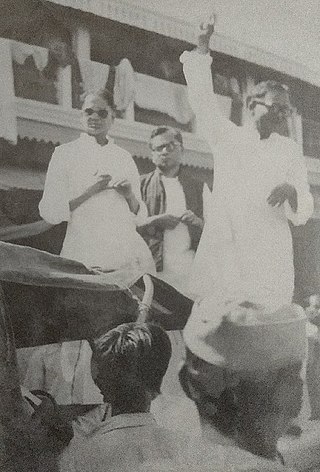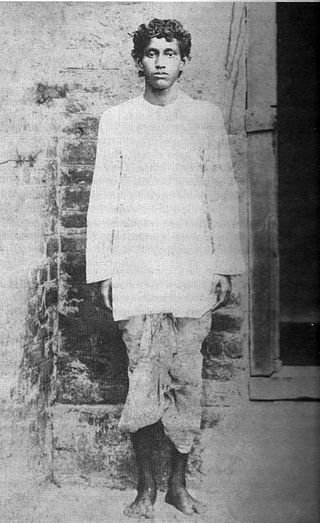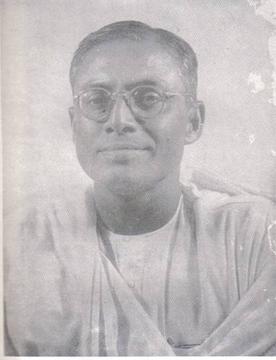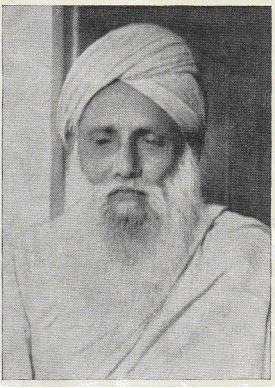
Revolutionary Socialist Party (RSP) is a communist party in India. The party was founded on 19 March 1940 by Tridib Chaudhuri and has its roots in the Bengali liberation movement Anushilan Samiti and the Hindustan Socialist Republican Army.

The Congress Socialist Party (CSP) was a socialist caucus within the Indian National Congress. It was founded in 1934 by Congress members who rejected what they saw as the anti-rational mysticism of Gandhi as well as the sectarian attitude of the Communist Party of India towards the Congress. Influenced by Fabianism as well as Marxism-Leninism, the CSP included advocates of armed struggle or sabotage (such as Yusuf Meherally, Jai Prakash Narayan, and Basawon Singh as well as those who insisted upon Ahimsa or Nonviolent resistance. The CSP advocated decentralized socialism in which co-operatives, trade unions, independent farmers, and local authorities would hold a substantial share of the economic power.

Khudiram Bose was an Indian nationalist from Bengal Presidency who opposed British rule of India. For his role in the Muzaffarpur Conspiracy Case, along with Prafulla Chaki, he was sentenced to death and subsequently executed by hanging, making him one of the youngest martyrs of the Indian Independence Movement.
Emperor vs Aurobindo Ghosh and others, colloquially referred to as the Alipore Bomb Case, the Muraripukur conspiracy, or the Manicktolla bomb conspiracy, was a criminal case held in India in 1908. The case saw the trial of a number of Indian nationalists of the Anushilan Samiti in Calcutta, under charges of "Waging war against the Government" of the British Raj. The trial was held at Alipore Sessions Court, Calcutta, between May 1908 and May 1909. The trial followed in the wake of the attempt on the life of Presidency Magistrate Douglas Kingsford in Muzaffarpur by Bengali nationalists Khudiram Bose and Prafulla Chaki in April 1908, which was recognised by the Bengal police as linked to attacks against the Raj in the preceding years, including attempts to derail the train carrying Lieutenant-Governor Sir Andrew Fraser in December 1907.

Anushilan Samiti was an Indian fitness club, which was actually used as an underground society for anti-British revolutionaries. In the first quarter of the 20th century it supported revolutionary violence as the means for ending British rule in India. The organisation arose from a conglomeration of local youth groups and gyms (akhara) in Bengal in 1902. It had two prominent, somewhat independent, arms in East and West Bengal, Dhaka Anushilan Samiti, and the Jugantar group.
The Revolutionary movement for Indian Independence was part of the Indian independence movement comprising the actions of violent underground revolutionary factions. Groups believing in armed revolution against the ruling British fall into this category, as opposed to the generally peaceful civil disobedience movement spearheaded by Mahatma Gandhi.
Jugantar or Yugantar was one of the two main secret revolutionary trends operating in Bengal for Indian independence. This association, like Anushilan Samiti, started in the guise of suburban fitness club. Several Jugantar members were arrested, hanged, or deported for life to the Cellular Jail in Andaman and many of them joined the Communist Consolidation in the Cellular Jail.

Barindra Kumar Ghosh or Barindra Ghosh, or, popularly, Barin Ghosh was an Indian revolutionary and journalist. He was one of the founding members of Jugantar Bengali weekly, a revolutionary outfit in Bengal. Barindra Ghosh was a younger brother of Sri Aurobindo.

Bhupendra Kumar Dutta was an Indian freedom fighter and a revolutionary who fought for Indian independence from British rule. In addition to his other specific contributions as a Jugantar leader, he holds the record of a hunger strike for 78 days in Bilaspur Jail in December 1917.

Jadu Gopal Mukherjee was a Bengali Indian revolutionary who, as the successor of Jatindranath Mukherjee or Bagha Jatin, led the Jugantar members to recognise and accept Gandhi's movement as the culmination of their own aspiration.

Panchanan Chakravarti was a Bengali Indian revolutionary, one of the creators of the Revolt group after the momentary unification of the Anushilan Samiti and the Jugantar in the 1920s. Friend of the poet Kazi Nazrul Islam, he was a close associate of Subhas Chandra Bose.

Bhavabhushan Mitra, or Bhaba Bhusan Mitter, alias Swami Satyananda Puri was a Bengali Indian freedom fighter and an influential social worker.

Atulkrishna Ghosh was an Indian revolutionary, member of the Anushilan Samiti, and a leader of the Jugantar movement involved in Hindu German Conspiracy during World War I.
Pandit Mokshada Charan Samadhyayi (1874–?) was a leading figure of the Jugantar movement.
The first Christmas Day plot was a conspiracy made by the Indian revolutionary movement in 1909: during the year-ending holidays, the Governor of Bengal organised at his residence a ball in the presence of the Viceroy, the Commander-in-Chief and all the high-ranking officers and officials of the Capital (Calcutta). The 10th Jat Regiment was in charge of the security. Indoctrinated by Jatindranath Mukherjee, its soldiers decided to blow up the ballroom and take advantage of destroying the colonial Government. In keeping with his predecessor Otto von Klemm, a friend of Lokmanya Tilak, on 6 February 1910, M. Arsenyev, the Russian Consul-General, wrote to St Petersburg that it had been intended to "arouse in the country a general perturbation of minds and, thereby, afford the revolutionaries an opportunity to take the power in their hands." According to R. C. Majumdar, "The police had suspected nothing and it is hard to say what the outcome would have been had the soldiers not been betrayed by one of their comrades who informed the authorities about the impending coup".

Hemchandra Das Kanungo was an Indian nationalist and a member of the Anushilan Samiti. Kanungo travelled to Paris in 1907, where he learnt the technique of assembling picric acid bombs from exiled Russian revolutionaries. Kanungo's knowledge was disseminated throughout Indian nationalist organisations in the Raj and abroad. In 1908, Kanungo was one of the principal co-accused with Aurobindo Ghosh in the Alipore Bomb Case (1908–09). He was sentenced to transportation for life in the Andamans, but was released in 1921.
Dhaka Anushilan Samiti was a branch of the Anushilan Samiti founded in the city of Dhaka in November 1905. Initially a group of eighty under the leadership of Pulin Behari Das, it "spread like wildfire" throughout the province of East Bengal. More than 500 branches were opened, linked by a "close and detailed organization" to Pulin's headquarters at Dhaka. It absorbed smaller groups in the province and soon overshadowed its parent organization in Calcutta. Branches of Dhaka Anushilan emerged in the towns of Jessore, Khulna, Faridpur, Rajnagar, Rajendrapur, Mohanpur, Barvali, Bakarganj and other places. Estimates of Dhaka Anushilan Samiti's reach show a membership of between 15,000 and 20,000 members.

Aurobindo's political career lasted only four years, from 1906 to 1910. Though he had been active behind the scene surveying, organizing and supporting the nationalist cause, ever since his return to India, especially during his excursions to Bengal. This period of his activity from 1906-1910 saw a complete transformation of India's political scene. Before Aurobindo began publishing his views, the Congress was an annual debating society whose rare victories had been instances of the empire taking a favourable view to its petitions. By the time Aurobindo left the field, the ideal of political independence had been firmly ingrained into the minds of people, and nineteen years later, it became the official raison d'être of the Congress.
The Rodda company arms heist took place on 26 August 1914 in Calcutta, British India. Members of the Jugantar faction of the Bengali revolutionary organisation Anushilan Samiti intercepted a shipment of Mauser Pistols and ammunition belonging to Messrs Rodda & co., a Calcutta gun dealer, while these were en route from the Customs house to the company's godown, and were able to make away with a portion the arms. The heist was a sensational incident, being described by The Statesman as the "Greatest daylight robbery". In the following years, the pistols and ammunitions were linked to almost all the incidences of nationalist struggles in Bengal. By 1922, the police had recovered most of the stolen arms.
Anarchism in Bangladesh has its roots in the ideas of the Bengali Renaissance and began to take influence as part of the revolutionary movement for Indian independence in Bengal. After a series of defeats of the revolutionary movement and the rise of state socialist ideas within the Bengali left-wing, anarchism went into a period of remission. This lasted until the 1990s, when anarchism again began to reemerge after the fracturing of the Communist Party of Bangladesh, which led to the rise of anarcho-syndicalism among the Bangladeshi workers' movement.










